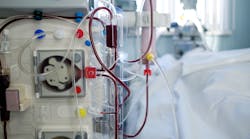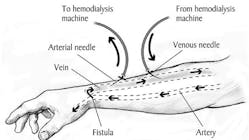Long-term hemodialysis is a lifesaver for the half a million U.S. patients with kidney failure who are waiting or unsuitable for kidney transplants. But before patients begin receiving dialysis to take over the kidneys’ functions of filtering and cleaning wastes from the blood, surgeons must construct a reusable access port to the circulatory system. This is usually done on the patient’s arm.
There are two surgical methods for creating this “vascular port.” One has better durability, performance, and safety. However, in a recent study using Medicare claims data, Johns Hopkins researchers found that 20% of veteran U.S. surgeons perform the less-preferred procedure too often, even when unnecessary. Researchers want to send those surgeons through peer evaluations of such performance in hopes that it will lead to improved practices.
The two types of vascular access surgeries for extended dialysis are the arteriovenous fistula (AVF) and the AV graft (AVG). The AVF is made by connecting a vein, most often in a patient’s arm, to a nearby artery. Over a period of two to three months, this bridge, or fistula, increases blood flow and pressure to the vein to enlarge and strengthen it. Once matured, the vein can withstand repeated needle insertions that would collapse an untreated vein or artery.
A diagram showing how kidney dialysis is conducted after an arteriovenous (AV) fistula surgery has provided access to the circulatory system. A new Johns Hopkins Medicine study reveals that many physicians are still performing a different, riskier procedure with a prosthetic graft for gaining access. (Credit: National Institute of Diabetes and Digestive and Kidney Diseases/National Institutes of Health)
In contrast, the AVG uses an artificial device, a plastic tube, to connect the artery and vein. It requires little healing time, so it can be used within four weeks of surgery. However, studies show AVGs are more likely than AVFs become infected and create blood clots, and therefore need more surgery to repair or replace it within a year. In addition, the average annual cost for creating and maintaining an AVG is $73,000—significantly higher than the $60,000 for maintaining an AVF, according to Medicare data.
The survey also uncovered some good news: The number of inappropriate vascular access surgeries to install ports for dialysis in the U.S. has declined. But the numbers also show that the U.S. has a way to go before meeting established standards that are already the norm in Europe and Asia.
Recognizing the distinct advantages of the fistula, the Federal Centers for Medicare & Medicaid Services and ESRD treatment networks across the U.S. organized the Fistula First Breakthrough Initiative in 2003. Its goal was to increase the use of AVFs to 50% of all vascular-port surgeries performed. When that goal was reached in 2009, the AVF-over-AVG standard was raised to 66% to try and match the 60% to 90% rates in Europe and Asia.
To document progress toward that goal and identify “physician characteristics” linked to higher-than-appropriate AVG use, Johns Hopkins researchers looked at Medicare fee-for-service claims data for more than 85,000 adult kidney-failure patients who received initial time vascular port surgeries between Jan. 1, 2016 and Dec. 31, 2017. They calculated the AVG rate for each of the 2,397 physicians who performed 10 or more procedures, AVF or AVG, in that time period. The median rate for the entire group was 18.2%, so the median rate for AVF surgeries was 81.8%.
The team also found that 498 physicians, approximately 21% (or 1 in 5), performed AVG surgeries in more than 34% of all their cases. This means they failed to meet the 66% or higher target standard for using VFGs. The study also indicated that most of physicians associated with high AVG use, including some who were using AVG in more than 80% of their cases, had long-established practices (a median of 35.5 years since graduating medical school), were located in an urban setting, and specialized in vascular surgery more than general surgery.
The best practice guidelines on AVFs and AVGs have only been around since 2003, so the team speculated that perhaps older physicians are simply less familiar with them and have continued “doing business as usual,” or they may be treating more complex cases and believe fistula access is less suitable. In either case, the researchers concluded that more education and targeted intervention using peer-to-peer evaluations to suggest a change in practice may help address the problem.


